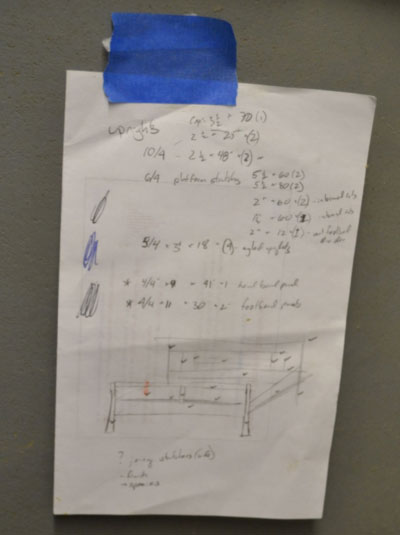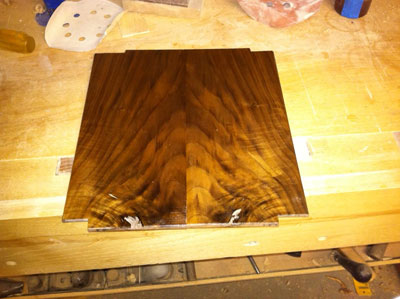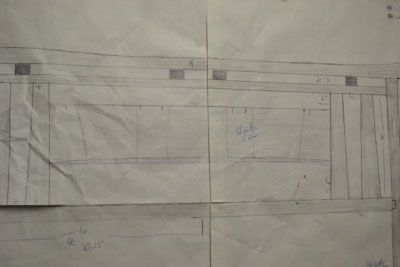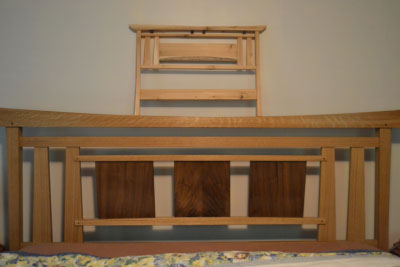Flexibility on the Design-Build Curve
by Tom LeRoy
Click on any picture to see a larger version.
Let's start with the obvious facts. I'm not a professional woodworker or a furniture designer. I'm just an average woodworker who likes to make cabinets and furniture that my family needs. This avocation began some twenty years ago when we bought an 18th century home in New Hampshire. In the ensuing two decades, my shop time has waxed and waned depending on the demands of my family and work.
Since we moved into our house in 2007, my wife and I have been sleeping on a mattress on the floor. Yes, she is a very patient woman. In 2009, I began noodling some sketches of an Arts and Crafts style bed but nothing was catching my fancy. I then came across an article that discussed how the Arts and Crafts designers were inspired by Japanese and Chinese furniture. This led me to Google image searching Japanese architecture and I came across images of the Torii gates with their gently sweeping curved tops. That design element was quickly integrated into my sketches but I was uncertain of the mid portion of the headboard design. During a plane trip, I used onion skin paper to play with various panels inspired by shoji designs.
In 2010, I finalized a scaled drawing that I was pretty pleased with. The central panel would have a straight top and a concave bottom edge with a contrasting wood edging to highlight the curvature and draw the eye to the detail. This design seemed to work and it would allow me to play around with different wood thicknesses as a design element, as well as giving me ample opportunity to improve my re-sawing skills at the bandsaw.
Michael Fortune's article on building scale models inspired me to use cedar, a hot glue gun, a brad nailer and a Sharpie to construct a scale model. My wife has difficulty interpreting two dimensional images so the model helped her to get a better sense of the design.
However, this model was the closest we would get to a bed for quite a while. I began a Master's degree program and my woodworking gave way to studying, reading journal articles, writing papers and developing my research project. I didn't begin the construction phase until after completing my degree. So, the Fall of 2013 finds me in New Hampshire, buying quartersawn and flatsawn white oak. With my daughter in college and my son rapidly approaching post-secondary education, I invest a lot of time picking the correct boards and making sure I have enough wood as is sufficient but as little as is necessary to get the job done.

|
Building the headboard is a journey of mortise and tenons. Dutifully, I plug along, roughing out the mortises with my drill press and finishing them up with hand chopping. The tenons are all cut by hand and trued up with shoulder plane and rabbeting block plane. I kept all of the stock square to simplify the joiner process. I hadn't template routed before, but chose that method to produce the gentle upsweeping curve on the top rail and the uprights. The methods work well and I really enjoy detailing these surfaces with drawknife and spokeshave to provide a visual interest and a tactile pleasure.
With the headboard dry fit together, I approach the task of resawing the quartersawn plank that will be bookmatched and visually center the headboard. After having practiced on scrap stock, I finally get the courage to get the panel resawn. I'm surprised by how well this goes and the boards get planed to equal thickness. When I begin to play around with the board alignment of the bookmatch, the panel even seems to call out for the concave bottom as the grain and some visible sapwood itself scribes this arc. All that is left is to glue up these two boards, profile the bottom edge and then begin joining them to the innermost uprights. I was a bit worried about how I would account for the wood movement of this panel but I had faith that it would all come together.

|
A picture of the book matched panel
that centered the bed design.
|
That proved to be no obstacle because my build process hit a serious snag before that step. When I took the panel out of the clamps, it was bowed along its length.
Having already resawn and planed the panel to 3/8", there was no way to flatten the panel. I then thought of various methods of holding the panel flat but didn't like the design implications. Having kept my lumber purchase closer towards the "as little as is sufficient" side of the equation, I would need more stock if I was going to stick to my original design. This was daunting because my local hardwood supplier is only open during the week and the dealer that I bought the current stock from was open on the weekends, but that would entail a 90-minute drive each way.
Krenov had talked about reacting to the wood instead of forcing the wood to a design. So I began to look at what stock I had in my shop for inspiration. I had some nice walnut boards leftover from a coffee table build and it was already planned to be the contrasting, accent wood at the bottom of the panel and the four blocks just below the top rail. Maybe the solution was residing in my lumber pile.
Having already deviated from my wood choice, I set about determining if the walnut should be used in the same style panel or if the design needed to be altered as well. My original design played off the relatively straight grain of the quartersawn white oak. The walnut stock had completely different grain with the end of the board even having a bit of a crotch effect. The options became clear: spend time and money getting more quartersawn white oak or re-work the central theme of the headboard design. However, once I had opened the possibility of change, the curiosity to see where this was going to lead carried the day. I stepped back from the workbench and instead, picked up the pencil.

|
It only took six lines to begin the path to a solution of integrating walnut panels into the design. I quickly saw the "crotch" portion of the board could be bookmatched and would form a central panel running vertically. Then to either side would be walnut panels with their grain running a bit at an angle. To avoid too much uniformity, I played around with the outer edges of the left and right panels being either curved or at least angled away from the vertical.
A design element that I couldn't work out on paper was the cross rails that would hold these walnut panels. As I began to saw this stock it dawned on me that this was the time to introduce a gentle curve to the top edge of the bottom rail. This rail would be convex which would have a similar effect to the original design's concave bottom of the central panel. Finally, I chose to have these top and bottom rails be thicker than the inner uprights to draw more attention to the center of the headboard and add a bit of exposed joinery. This also adds a bit of visual surprise as every other element gets thinner as the design progresses inward. Now with the walnut's three panel starring role, the four small, accent blocks of walnut were no longer needed between the top rail and the upper crossing rail.

|
Although I'm certain my wife would say any bed that elevated our mattress off of the floor was wonderful, I do feel that this bed raised my woodworking and design skills. The evolution of this project illustrates one of my favorite quotes that I came across in a leadership seminar:
Visions don't change, they are only refined. Plans rarely stay the same, and are scrapped or adjusted as needed. Be stubborn about the vision, but flexible with your plan.
-John C. Maxwell
You can email Tom at
tplergo@yahoo.com
.
Return to
Wood News
front page


